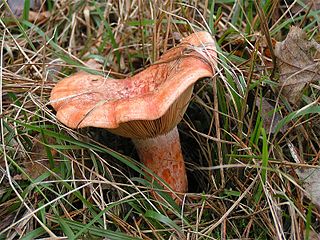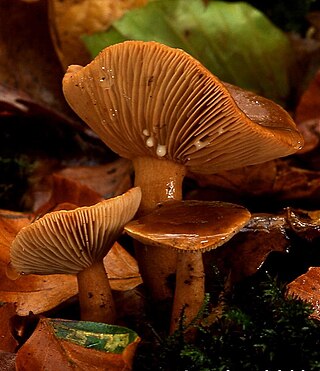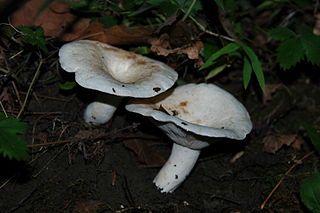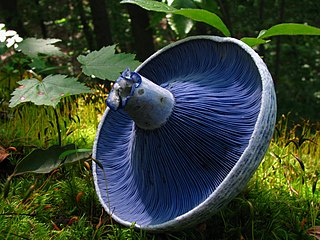
Lactarius is a genus of mushroom-producing, ectomycorrhizal fungi, containing several edible species. The species of the genus, commonly known as milk-caps, are characterized by the milky fluid ("latex") they exude when cut or damaged. Like the closely related genus Russula, their flesh has a distinctive brittle consistency. It is a large genus with over 500 known species, mainly distributed in the Northern hemisphere. Recently, the genus Lactifluus has been separated from Lactarius based on molecular phylogenetic evidence.

Lactarius deterrimus, also known as false saffron milkcap or orange milkcap, is a species of fungus in the family Russulaceae. The fungus produces medium-sized fruit bodies (mushrooms) with orangish caps up to 12 centimetres wide that develop green spots in old age or if injured. Its orange-coloured latex stains maroon within 30 minutes. Lactarius deterrimus is a mycorrhizal fungus that associates with Norway spruce and bearberry. The species is distributed in Europe, but has also found in parts of Asia. A visually similar species in the United States and Mexico is not closely related to the European species. Fruit bodies appear between late June and November, usually in spruce forests. Although the fungus is edible—like all Lactarius mushrooms from the section Deliciosi—its taste is often bitter, and it is not highly valued. The fruit bodies are used as source of food for the larvae of several insect species. Lactarius deterrimus can be distinguished from similar Lactarius species by difference in the mycorrhizal host or latex colour.

Lactarius deliciosus, commonly known as the delicious milk cap, saffron milk cap and red pine mushroom, is one of the best known members of the large milk-cap genus Lactarius in the order Russulales. It is native to Europe, but has been accidentally introduced to other countries along with pine trees, with which the fungus is symbiotic.

Lactarius controversus, commonly known as the poplar milkcap, is a large funnel-capped fungus within the genus Lactarius, which are collectively known as 'milk caps'. They all exude milky drops (lactate) from the flesh and gills when damaged.

Lactifluus vellereus, commonly known as the fleecy milk-cap, is a quite large fungus in the genus Lactifluus. It is one of the two most common milk-caps found with beech trees, with the other being Lactarius subdulcis.

Milk-cap is a common name that refers to mushroom-forming fungi of the genera Lactarius, Lactifluus, and Multifurca, all in the family Russulaceae. The common and eponymous feature of their fruitbodies is the latex ("milk") they exude when cut or bruised. Mushrooms with typical milk-cap characteristics are said to have a lactarioid habit. Some of them are edible.

Lactarius uvidus, commonly known as the purple staining milk cap, is a European and North American "milk-cap" mushroom, of which the milk turns violet when the flesh is damaged. The fungi generally identified as L. uvidus are part of a complex of closely related species and varieties which are difficult to delimit definitively.

Lactarius pyrogalus, commonly known as the fire-milk lactarius, is a species of inedible mushroom in genus Lactarius. It is greyish and differentiated from other grey Lactarius by its widely spaced, yellow gills. It is found on the forest floor in mixed woodland, especially at the base of hazel trees.

Lactarius subdulcis, commonly known as the mild milkcap or beech milk cap, is an edible mushroom in the genus Lactarius. It is brown in colour, with a large number of gills and a particularly thin layer of flesh in the cap. Mycorrhizal, the mushroom is found from late summer to late autumn at the base of beech trees in small groups or individually, where it is one of the two most common species of fungi. Alternatively, it can be found in large groups in fields, sometimes with more than a hundred individual mushrooms. It is found in Europe, and, despite previous research to the contrary, is absent in North America. Although considered edible, it is not particularly useful as food due to its ivy-like taste and the fact that more choice mushrooms will be easily found at the same time. L. subdulcis is known for its abundant, sweet-tasting milk that, unlike the latex of some of its relatives, does not stain fabric yellow.

Lactifluus piperatus, commonly known as the blancaccio, is a semi-edible basidiomycete fungus of the genus Lactifluus. Despite being edible, it is not recommended by some because of its poor taste, though can be used as seasoning when dried. The fruiting body is a creamy-white mushroom which is funnel-shaped when mature, with exceptionally crowded gills. It bleeds a whitish peppery-tasting milk when cut. Widely distributed across Europe and eastern North America, Lactifluus piperatus has been accidentally introduced to Australia. Mycorrhizal, it forms a symbiotic relationship with various species of deciduous tree, including beech, and hazel, and fruiting bodies are found on the forest floor in deciduous woodland.

Lactifluus volemus, formerly known as Lactarius volemus, and commonly known as the weeping milk cap or bradley, is a species of fungus in the family Russulaceae. It is widely distributed in the northern hemisphere, in temperate regions of Europe, North America and Asia as well as some subtropical and tropical regions of Central America and Asia. A mycorrhizal fungus, its fruit bodies grow on the ground at the base of various species of trees from summer to autumn, either individually or in groups. It is valued as an edible mushroom, and is sold in markets in Asia. Several other Lactifluus mushrooms resemble L. volemus, such as the closely related edible species L. corrugis, but these can be distinguished by differences in distribution, visible morphology, and microscopic characteristics. L. volemus produces a white spore print and has roughly spherical spores about 7–8 micrometres in diameter.

Lactarius glyciosmus, commonly known as the coconut scented milk cap, is a semi-edible mushroom in the genus Lactarius. Mycorrhizal, it can be found growing in soil at the base of birch trees in Europe. It is typically coloured a greyish lilac, with the sometimes hollow stem a little lighter coloured than the cap. It has crowded, decurrent gills, and smells strongly of coconuts.

Lactarius tabidus, commonly known as the birch milkcap, is an inedible mushroom of the genus Lactarius. It can be found in North America and Europe, and grows at the base of pine in Autumn. Its white milk stains fabric a sulphur yellow, from which its specific epithet derives.

Lactarius indigo, commonly known as the indigo milk cap, indigo milky, the indigo lactarius, or the blue milk mushroom, is a species of agaric fungus in the family Russulaceae. It is a widely distributed species, growing naturally in eastern North America, East Asia, and Central America; it has also been reported in southern France. L. indigo grows on the ground in both deciduous and coniferous forests, where it forms mycorrhizal associations with a broad range of trees. The fruit body color ranges from dark blue in fresh specimens to pale blue-gray in older ones. The milk, or latex, that oozes when the mushroom tissue is cut or broken — a feature common to all members of the genus Lactarius — is also indigo blue, but slowly turns green upon exposure to air. The cap has a diameter of 5–15 cm (2–6 in), and the stem is 2–8 cm (0.8–3 in) tall and 1–2.5 cm (0.4–1.0 in) thick. It is an edible mushroom, and is sold in rural markets in China, Guatemala, and Mexico. In Honduras, the mushroom is called a chora, and is generally eaten with egg; generally as a side dish for a bigger meal.

Lactarius subflammeus, commonly known as the orange milk cap, is a species of fungus in the family Russulaceae. It is found in western North America in the late summer and fall and is especially common in the Pacific Northwest, where it grows on the ground near conifers like pine and spruce. The brightly colored fruit bodies, which are slimy or sticky, have scarlet caps when young that soon fade to brilliant orange. The stem—typically longer than the width of the cap—is also bright orange but the gills are whitish. The mushroom secretes a whitish latex when it is cut or injured.

Lactarius affinis, commonly known as the kindred milk cap, is a species of milk-cap mushroom in the family Russulaceae. It is found northeastern North America, where it fruits in the summer and fall, and is common in the Great Lakes region. Its fruit bodies have medium to large, slimy dull yellow or brownish caps. Although not considered poisonous, it is unpalatable because of its highly acrid taste.

Lactarius fallax, commonly known as the velvety milk cap, is a species of fungus in the family Russulaceae. Found in both spruce and mixed conifer forests, it is a fairly common species in the Pacific Northwest region of North America, with a northerly range extending to Alaska. Its fruit bodies are medium-sized, with velvety, brown to blackish caps up to 3–9 cm (1.2–3.5 in) in diameter bearing a distinct pointed umbo. The caps are supported by velvety stems up to 6 cm (2.4 in) long and 1.5 cm (0.6 in) thick. The mushroom oozes a whitish latex when it is cut, and injured tissue eventually turns a dull reddish color. The eastern North American and European species Lactarius lignyotus is closely similar in appearance, but can be distinguished by its differing range.

Lactifluus deceptivus, commonly known as the deceiving milkcap, is a common species of fungus in the family Russulaceae. It is found throughout eastern North America on the ground in coniferous forests near hemlock or deciduous forests near oak, and in oak-dominated forests of Costa Rica. It produces large mushrooms with funnel-shaped caps reaching up to 25 cm (9.8 in) in diameter, on top of hard white stems that may reach 4–10 cm (1.6–3.9 in) long and up to 3 cm (1.2 in) thick. The gills are closely spaced together and yellowish-cream in color. When young, the cap is white in all parts, but the depressed center becomes dull brownish in age and breaks up into scales. The edge of the cap has a roll of cottony tissue that collapses as the cap expands. The surface of the stem—especially near the base—has a velvety texture. The mushroom "bleeds" a milky white acrid latex when it is cut or injured. Similar milk-cap species with which L. deceptivus might be confused include Lactifluus piperatus, L. pseudodeceptivus, L. caeruleitinctus, L. subvellereus, Lactarius arcuatus and Lactarius parvulus.

Lactifluus is one of three genera of mushroom-forming fungi containing species commonly named "milk-caps", the others being Lactarius and Multifurca. It has been separated from Lactarius based on molecular phylogenetic evidence but is very similar to that genus. There are roughly 150 known Lactifluus species, which have a mainly tropical distribution but are also found in the north temperate zone and Australasia. Some of them are edible mushrooms.



















